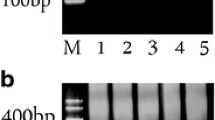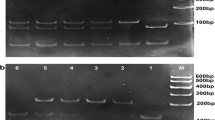Abstract
miR-17-92 cluster was differentially expressed in cervical cancer, playing an important role in regulating cell proliferation, apoptosis, migration, and invasion. The purpose of this study was to investigate the association between polymorphisms (i.e., rs9588884, rs982873, and rs1813389) in the promoter of miR-17-92 and the risk of cervical squamous cell carcinoma (CSCC). The rs9588884 polymorphism was genotyped using a Taqman assay and the rs982873 and rs1813389 polymorphisms were genotyped using a polymerase chain reaction-restriction fragment length polymorphism method. The expression levels of miR-17-92 were determined using a quantitative PCR analysis. The rs9588884 GG genotype was associated with a reduced risk of CSCC in homozygote comparison (adjusted OR = 0.47, 95% CI, 0.30–0.75, P = 0.001), dominant model (adjusted OR = 0.67, 95% CI, 0.50–0.91, P = 0.01), and recessive model (adjusted OR = 0.57, 95% CI, 0.38–0.85, P = 0.01). The rs9588884 G allele was also associated with a reduced risk of CSCC in allele comparison (adjusted OR = 0.71, 95% CI, 0.58–0.88, P = 0.002). Moreover, patients with the rs9588884 GG genotype had lower levels of miR-20a compared with the rs9588884 CC genotype (P = 0.03). These findings indicate that the rs9588884 GG genotype was associated with lower levels of miR-20a and eventually related to the risk of CSCC in Chinese women.

Similar content being viewed by others
References
Bray F, Ferlay J, Soerjomataram I, Siegel RL, Torre LA, Jemal A. Global cancer statistics 2018: GLOBOCAN estimates of incidence and mortality worldwide for 36 cancers in 185 countries. CA Cancer J Clin. 2018;68:394–424.
Otter S, Whitaker S, Chatterjee J, Stewart A. The human papillomavirus as a common pathogen in oropharyngeal, anal and cervical cancers. Clin Oncol (R Coll Radiol). 2019;31:81–90.
Berman TA, Schiller JT. Human papillomavirus in cervical cancer and oropharyngeal cancer: one cause, two diseases. Cancer. 2017;123:2219–29.
Wardak S. Human Papillomavirus (HPV) and cervical cancer. Med Dosw Mikrobiol. 2016;68:73–84.
Gadducci A, Barsotti C, Cosio S, Domenici L, Riccardo GA. Smoking habit, immune suppression, oral contraceptive use, and hormone replacement therapy use and cervical carcinogenesis: a review of the literature. Gynecol Endocrinol. 2011;27:597–604.
Ruan K, Fang X, Ouyang G. MicroRNAs: novel regulators in the hallmarks of human cancer. Cancer Lett. 2009;285:116–26.
Kang HW, Wang F, Wei Q, Zhao YF, Liu M, Li X, et al. miR-20a promotes migration and invasion by regulating TNKS2 in human cervical cancer cells. FEBS Lett. 2012;586:897–904.
Servin-Gonzalez LS, Granados-Lopez AJ, Lopez JA. Families of microRNAs expressed in clusters regulate cell signaling in cervical cancer. Int J Mol Sci. 2015;16:12773–90.
Konicke K, Lopez-Luna A, Munoz-Carrillo JL, et al. The microRNA landscape of cutaneous squamous cell carcinoma. Drug Discov Today. 2018;23:864–70.
Cheung TH, Man KN, Yu MY, Yim SF, Siu NS, Lo KW, et al. Dysregulated microRNAs in the pathogenesis and progression of cervical neoplasm. Cell Cycle. 2012;11:2876–84.
Wei Q, Li YX, Liu M, Li X, Tang H. MiR-17-5p targets TP53INP1 and regulates cell proliferation and apoptosis of cervical cancer cells. IUBMB Life. 2012;64:697–704.
Xu XM, Wang XB, Chen MM, Liu T, Li YX, Jia WH, et al. MicroRNA-19a and -19b regulate cervical carcinoma cell proliferation and invasion by targeting CUL5. Cancer Lett. 2012;322:148–58.
Rao Q, Shen Q, Zhou H, Peng Y, Li J, Lin Z. Aberrant microRNA expression in human cervical carcinomas. Med Oncol. 2012;29:1242–8.
Chen J, Yao D, Li Y, Chen H, He C, Ding N, et al. Serum microRNA expression levels can predict lymph node metastasis in patients with early-stage cervical squamous cell carcinoma. Int J Mol Med. 2013;32:557–67.
Zhao S, Yao DS, Chen JY, Ding N. Aberrant expression of miR-20a and miR-203 in cervical cancer. Asian Pac J Cancer Prev. 2013;14:2289–93.
Zhou Q, Dong J, Luo R, Zhou X, Wang J, Chen F. MicroRNA-20a regulates cell proliferation, apoptosis and autophagy by targeting thrombospondin 2 in cervical cancer. Eur J Pharmacol. 2019;844:102–9.
Zhao S, Yao D, Chen J, Ding N, Ren F. MiR-20a promotes cervical cancer proliferation and metastasis in vitro and in vivo. PLoS One. 2015;10:e0120905.
Liu J, Ni S. Association between genetic polymorphisms in the promoters of let-7 and risk of cervical squamous cell carcinoma. Gene. 2018;642:256–60.
Wang S, Cao X, Ding B, Chen J, Cui M, Xu Y, et al. The rs767649 polymorphism in the promoter of miR-155 contributes to the decreased risk for cervical cancer in a Chinese population. Gene. 2016;595:109–14.
Liang Y, Sun R, Li L, et al. A functional polymorphism in the promoter of MiR-143/145 is associated with the risk of cervical squamous cell carcinoma in Chinese women: a case-control study. Medicine (Baltimore). 2015;94:e1289.
Huang J, Ni S, Li D, He Y. An insertion/deletion polymorphism at miRNA-122 binding site in the IL1A is associated with a reduced risk of cervical squamous cell carcinoma. Genet Test Mol Biomarkers. 2015;19:331–4.
Sun R, Liang Y, Yuan F, Nie X, Sun H, Wang Y, et al. Functional polymorphisms in the promoter region of miR-17-92 cluster are associated with a decreased risk of colorectal cancer. Oncotarget. 2017;8:82531–40.
Livak KJ, Schmittgen TD. Analysis of relative gene expression data using real-time quantitative PCR and the 2(-Delta Delta C(T)) Method. Methods. 2001;25:402–8.
Nair VB, Manasa VG, Sinto MS, Jayasree K, James FV, Kannan S. Differential expression of microRNAs in uterine cervical cancer and its implications in carcinogenesis: an integrative approach. Int J Gynecol Cancer. 2018;28:553–62.
Pedroza-Torres A, Lopez-Urrutia E, Garcia-Castillo V, et al. MicroRNAs in cervical cancer: evidences for a miRNA profile deregulated by HPV and its impact on radio-resistance. Molecules. 2014;19:6263–81.
Ding H, Wu YL, Wang YX, Zhu FF. Characterization of the microRNA expression profile of cervical squamous cell carcinoma metastases. Asian Pac J Cancer Prev. 2014;15:1675–9.
Sand M, Hessam S, Amur S, Skrygan M, Bromba M, Stockfleth E, et al. Expression of oncogenic miR-17-92 and tumor suppressive miR-143-145 clusters in basal cell carcinoma and cutaneous squamous cell carcinoma. J Dermatol Sci. 2017;86:142–8.
Chhabra R. let-7i-5p, miR-181a-2-3p and EGF/PI3K/SOX2 axis coordinate to maintain cancer stem cell population in cervical cancer. Sci Rep. 2018;8:7840.
Chen Y, Ma C, Zhang W, Chen Z, Ma L. Down regulation of miR-143 is related with tumor size, lymph node metastasis and HPV16 infection in cervical squamous cancer. Diagn Pathol. 2014;9:88.
Liu L, Yu X, Guo X, et al. miR-143 is downregulated in cervical cancer and promotes apoptosis and inhibits tumor formation by targeting Bcl-2. Mol Med Rep. 2012;5:753–60.
Chen Z, Han Y, Song C, Wei H, Chen Y, Huang K, et al. Systematic review and meta-analysis of the prognostic significance of microRNAs in cervical cancer. Oncotarget. 2018;9:17141–8.
Wei H, Wen-Ming C, Jun-Bo J. Plasma miR-145 as a novel biomarker for the diagnosis and radiosensitivity prediction of human cervical cancer. J Int Med Res. 2017;45:1054–60.
Lu H, He Y, Lin L, Qi Z, Ma L, Li L, et al. Long non-coding RNA MALAT1 modulates radiosensitivity of HR-HPV+ cervical cancer via sponging miR-145. Tumour Biol. 2016;37:1683–91.
Fang H, Shuang D, Yi Z, Sheng H, Liu Y. Up-regulated microRNA-155 expression is associated with poor prognosis in cervical cancer patients. Biomed Pharmacother. 2016;83:64–9.
Wang F, Shan S, Huo Y, Xie Z, Fang Y, Qi Z, et al. MiR-155-5p inhibits PDK1 and promotes autophagy via the mTOR pathway in cervical cancer. Int J Biochem Cell Biol. 2018;99:91–9.
Author information
Authors and Affiliations
Contributions
HJ designed and wrote the manuscript. Ni S performed sample collection and performed experiments. Tang R performed statistical analysis.
Corresponding author
Ethics declarations
This study was carried out in accordance with the recommendations of the Institutional Human Ethics Committee of the Chengdu Women’s and Children’s Central Hospital with written informed consent from all subjects. All subjects gave written informed consent in accordance with the Declaration of Helsinki. The protocol was approved by the Institutional Human Ethics Committee of the Chengdu Women’s and Children’s Central Hospital.
Conflict of Interest
The authors declare that they have no conflict of interest.
Additional information
Publisher’s Note
Springer Nature remains neutral with regard to jurisdictional claims in published maps and institutional affiliations.
Rights and permissions
About this article
Cite this article
Huang, J., Ni, S. & Tang, R. A Functional Polymorphism in the Promoter of miR-17-92 is Associated with a Reduced Risk of Cervical Squamous Cell Carcinoma. Reprod. Sci. 27, 87–92 (2020). https://doi.org/10.1007/s43032-019-00007-6
Received:
Accepted:
Published:
Issue Date:
DOI: https://doi.org/10.1007/s43032-019-00007-6




